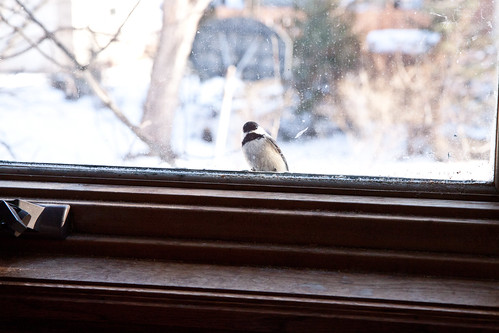 |
| Mark Roser's Tufted Titmouse "Wink." © 2021 by Mark Roser |
A couple of weeks ago, a podcast listener named Mark Roser, who is working on a small guide to hand feeding birds, wrote to me, attaching an adorable photo of a Tufted Titmouse he calls Wink because the little bird has what looks like an extra eye patch on one side. Mark writes:
Tufted Titmice are gems. When hand feeding with me, they much prefer to lurk 10 feet away and wait for a chickadee to push a nut out of the hand and onto the ground, so they can swoop in and out quickly. :) Wink is a funny guy - he will approach me and wait 3 feet away, and then pause to reflect on whether the nuts he sees are worth the awkwardness of jumping closer to a human hand. But that goes out the window as soon as another bird also lands nearby, at which point he jumps right in because his competitive spirit would not want to take 2nd place to anyone else :)
When we hand feed birds or watch them closely at a window feeder, we get close enough that we can’t help but notice how individual each bird is, expanding our understanding of avian intelligence as well, as we realize that these little guys are guided by a heck of a lot more than the simple, almost robotic instincts some people once believed.
This week I got an anonymous comment on a blogpost from 2013 that I’d titled “Chickadee Day.” They wrote:
I loved reading this. I recently put up a bird feeder and a bird bath right outside the window of my home office and have been getting tremendous enjoyment watching a variety of birds each day. But none have captivated my heart as much as a little Chickadee that has starting landing on my window and tapping at it over the past few days! This same little fellow also likes to sit on top of the bird feeder pole and watch me. How utterly endearing! Thank you for writing about them and sharing that one has done the same at your home. Do you have any tips on how to get them to eat from your hand? I see you mentioned mealworms - I will definitely buy some of those but would love any tips on how to encourage hand feeding. Thank you!
Even as some of our birds learn to associate us with keeping the feeders full, they're usually still reluctant to come to our hands—that seems risky, and why take that risk when plenty of food is available in feeders? I did have plenty of feeders out when I first started hand-feeding, but the only place I offered live mealworms was in my small home office window feeder, and because starlings could make short work of them, I only put out a few, and only when I noticed the chickadees were about. I’d whistle the chickadee song as I cranked open the window each time. This was in winter, and even with plenty of sunflower seeds and suet, live mealworms were especially delectable, so within a few days a whole flock of chickadees would fly in the moment they heard the whistle. And then one day, during a blizzard, the moment my mealworm-laden hand emerged from the window, a chickadee who was either exceptionally bold, impatient, hungry, or all three flew straight to my hand, grabbed a mealworm, and flew off. The next time I filled the feeder, a couple of chickadees grabbed their mealworms straight from my hand before I could fill the feeder, and soon the whole flock was coming to my hand all the time.
I can’t wait to see what Mark Roser writes about hand feeding. Meanwhile, this year I’m whistling to get the chickadees to come to the feeder for mealworms so I can be holding Walter up to the window to watch them come and go. As rich as my delight when chickadees alight on my hand and look into my eyes, watching Walter’s eyes light up to see them so close is even richer.

